Superregnum: Eukaryota
Cladus: Unikonta
Cladus: Opisthokonta
Cladus: Holozoa
Regnum: Animalia
Subregnum: Eumetazoa
Cladus: Bilateria
Cladus: Nephrozoa
Superphylum: Deuterostomia
Phylum: Chordata
Subphylum: Vertebrata
Infraphylum: Gnathostomata
Megaclassis: Osteichthyes
Cladus: Sarcopterygii
Cladus: Rhipidistia
Cladus: Tetrapodomorpha
Cladus: Eotetrapodiformes
Cladus: Elpistostegalia
Superclassis: Tetrapoda
Cladus: Reptiliomorpha
Cladus: Amniota
Classis: Reptilia
Cladus: Eureptilia
Cladus: Romeriida
Subclassis: Diapsida
Cladus: Sauria
Infraclassis: Archosauromorpha
Cladus: Crurotarsi
Divisio: Archosauria
Cladus: Avemetatarsalia
Cladus: Ornithodira
Subtaxon: Dinosauromorpha
Cladus: Dinosauriformes
Cladus: Dracohors
Cladus: Dinosauria
Cladus: Saurischia
Cladus: Eusaurischia
Subordo: Theropoda
Cladus: Neotheropoda
Cladus: Averostra
Cladus: Tetanurae
Cladus: Avetheropoda
Cladus: Coelurosauria
Cladus: Tyrannoraptora
Cladus: Maniraptoromorpha
Cladus: Maniraptoriformes
Cladus: Maniraptora
Cladus: Pennaraptora
Cladus: Paraves
Cladus: Eumaniraptora
Cladus: Avialae
Infraclassis: Aves
Cladus: Avebrevicauda
Cladus: Pygostylia
Cladus: Ornithothoraces
Cladus: Ornithuromorpha
Cladus: Carinatae
Parvclassis: Neornithes
Cohors: Neognathae
Cladus: Neoaves
Cladus: Telluraves
Cladus: Australaves
Ordo: Passeriformes
Subordo: Passeri
Infraordo: Passerida
Superfamilia: Passeroidea
Familia: Passeridae
Genus: Passer
Species: P. ammodendri – P. castanopterus – P. cinnamomeus – P. cordofanicus – P. diffusus – P. domesticus – P. eminibey – P. euchlorus – P. flaveolus – P. gongonensis – P. griseus – P. hemileucus – P. hispaniolensis – P. iagoensis – P. insularis – P. italiae – P. luteus – P. melanurus – P. moabiticus – P. montanus – P. motitensis – P. pyrrhonotus – P. rufocinctus – P. shelleyi – P. simplex – P. suahelicus – P. swainsonii – P. zarudnyi
Species extincta: †P. hiri
Name
Passer Brisson, 1760
Typus
Fringilla domestica Linnaeus, 1758 = Passer domesticus
Synonymy
Pyrgita Cuvier, 1817
Corospiza Bonaparte, 1850
Auripasser Bonaparte, 1851
Sorella Hartlaub, 1880
Ammopasser Zarudny, 1880
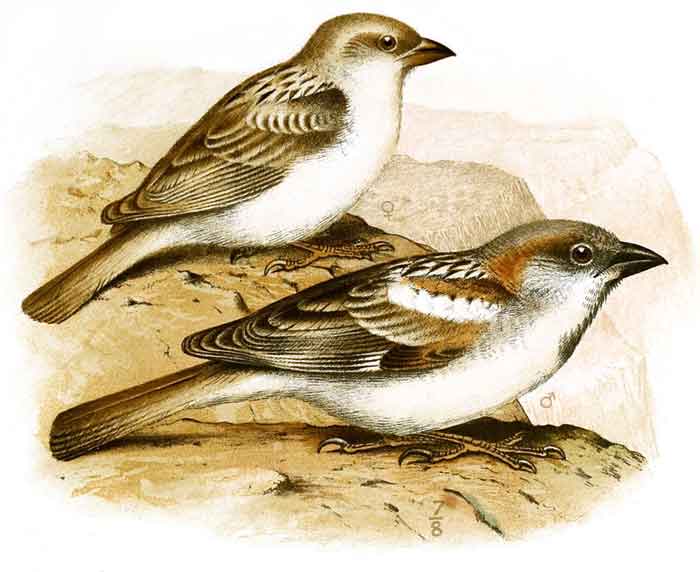
Passer hemileucus
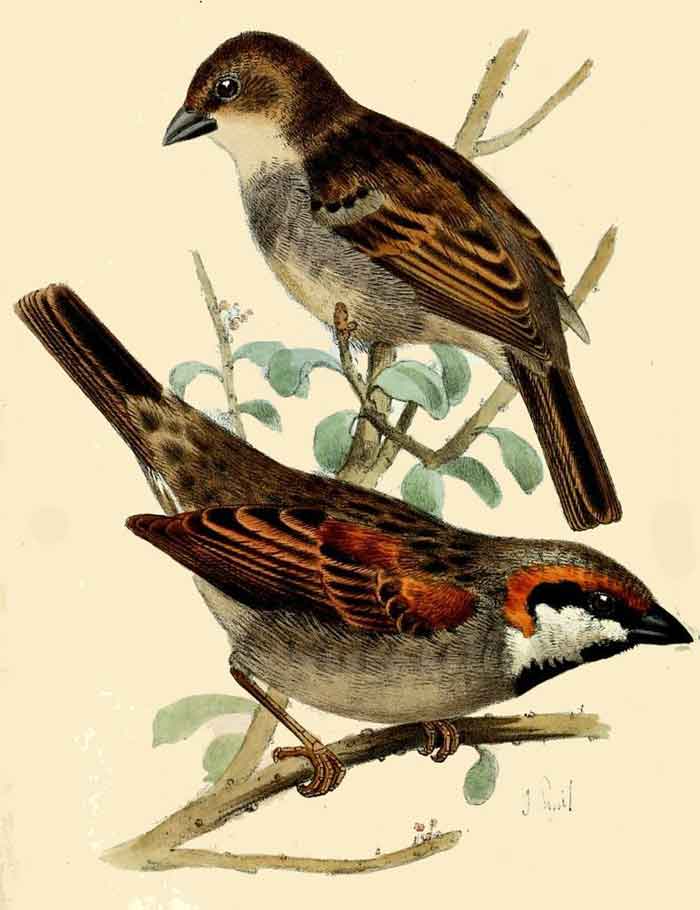
Passer insularis
References
Brisson, M.J. 1760. Ornithologie ou méthode contenant la division des oiseaux en ordres, sections, genres, especes & leurs variétés. A laquelle on a joint une description exacte de chaque espece, avec les citations des auteurs qui en ont traité, les noms qu'ils leur ont donnés, ceux que leur ont donnés les différentes nations, & les noms vulgaires. Ouvrage enrichi de figures en taille-douce. Tome I. - pp. j-xxiv [= 1-24], 1-526, j-lxxiij [= 1-73], Pl. I-XXXVII [= 1-37]. Paris. (Bauche). : 36 BHL Reference page. pl.I, fig.6 BHL
Vernacular names
العربية: دوري
беларуская: Вераб’і
български: Врабчета
буряад: Борбилоо
dansk: Spurv
Deutsch: Sperling
English: Sparrow
Esperanto: Pasero
español: Gorrión
eesti: Varblane
فارسی: گنجشکهای اصلی
suomi: Varpuset
עברית: דרור
Ido: Pasero
italiano: Passeri
日本語: スズメ属
ქართული: ბეღურა
қазақша: Торғайлар
кыргызча: Таранчы
lingála: Alíkilíkoso
latviešu: Zvirbuļi
монгол: Боршувуу
кырык мары: Лачокла оравивлӓ
português: Pardal
Runa Simi: Parya
русский: Настоящие воробьи
српски / srpski: Врабац - Vrabac
Kiswahili: Shomoro
தமிழ்: பேசர்
татарча / tatarça: Чыпчыклар
українська: Горобець
oʻzbekcha / ўзбекча: Chumchuqlar
閩南語 / Bân-lâm-gú: Chhù-chiáu
中文: 麻雀屬
Passer is a genus of sparrows, also known as the true sparrows. The genus contains 28 species and includes the house sparrow and the Eurasian tree sparrow, two of the most common birds in the world. They are small birds with thick bills for eating seeds, and are mostly coloured grey or brown. Native to the Old World, some species have been introduced throughout the world.
Taxonomy
The genus Passer was introduced by the French zoologist Mathurin Jacques Brisson in 1760.[2][3] The type species was subsequently designated as the house sparrow (Passer domesticus).[3][4] The name Passer is the Latin word for "sparrow."[5]
A mixed group of Passer sparrows containing a Eurasian tree sparrow, a male house sparrow, and female house or Spanish sparrows, feeding on grain in the town of Baikonur, Kazakhstan
Species
The genus contains 28 species:[6][7]
| Image | Common Name | Scientific name | Distribution |
|---|---|---|---|
 |
Cape sparrow | Passer melanurus | central coast of Angola to eastern South Africa and Swaziland |
 |
Chestnut sparrow | Passer eminibey | Darfur in Sudan to Tanzania |
| Kordofan sparrow | Passer cordofanicus | South Sudan and Chad | |
 |
Shelley's sparrow | Passer shelleyi | eastern Africa from South Sudan, southern Ethiopia, and north-western Somalia to northern Uganda and north-western Kenya |
 |
Kenya sparrow | Passer rufocinctus | Kenya and Tanzania |
 |
Great sparrow | Passer motitensis | southern Africa |
 |
Northern grey-headed sparrow | Passer griseus | tropical Africa |
 |
Swainson's sparrow | Passer swainsonii | northeastern Africa |
 |
Swahili sparrow | Passer suahelicus | southern Kenya and Tanzania |
 |
Parrot-billed sparrow | Passer gongonensis | eastern Africa |
 |
Southern grey-headed sparrow | Passer diffusus | Angola and Zambia southwards into South Africa |
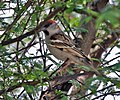 |
Sind sparrow | Passer pyrrhonotus | Indus valley region in South Asia |
 |
Russet sparrow | Passer cinnamomeus | southeastern Tibet, Bhutan, Sikkim, Nepal, Uttarakhand, and Himachal Pradesh to Kashmir and Nuristan in Afghanistan, as well as China, Korea, and Japan |
 |
Eurasian tree sparrow | Passer montanus | Temperate Eurasia and Southeast Asia. Introduced in Sardinia, eastern Indonesia, the Philippines, Micronesia, Victoria and New South Wales in Australia and the U.S. states of Missouri, Illinois and Iowa. |
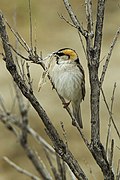 |
Saxaul sparrow | Passer ammodendri | Central Asia |
 |
Plain-backed sparrow | Passer flaveolus | Myanmar to central Vietnam, and south to the western part of Peninsular Malaysia |
 |
Abd al-Kuri sparrow | Passer hemileucus | Abd al Kuri in the Socotra archipelago |
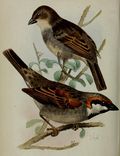 |
Socotra sparrow | Passer insularis | islands of Socotra, Samhah, and Darsah |
 |
Spanish sparrow | Passer hispaniolensis | Mediterranean region, Macaronesia and south-west and central Asia |
 |
Italian sparrow | Passer italiae | northern and central Italy, Corsica, and small parts of France,Switzerland, Austria, and Slovenia |
 |
House sparrow | Passer domesticus | Middle East, Eurasia and parts of North Africa. Introduced in subarctic North America, southern South America, southern Africa, eastern Australia, New Zealand and Hawaii |
 |
Somali sparrow | Passer castanopterus | northern Somalia, Djibouti, Ethiopia and Kenya. |
 |
Iago sparrow | Passer iagoensis | archipelago of Cape Verde |
 |
Desert sparrow | Passer simplex | Sahara Desert of northern Africa |
 |
Zarudny's sparrow | Passer zarudnyi | Uzbekistan and Turkmenistan |
 |
Arabian golden sparrow | Passer euchlorus | south west Arabia and also the coast of Somalia and Djibouti |
 |
Sudan golden sparrow | Passer luteus | sub-Saharan Africa |
 |
Dead Sea sparrow | Passer moabiticus | Middle East and another in western Afghanistan and eastern Iran |
Besides these living species, there are questionable fossils from as long ago as the Early Miocene,[8] and Passer predomesticus, from the Middle Pleistocene.
Description
A great sparrow in Marakele National Park, South Africa
These sparrows are plump little brown or greyish birds, often with black, yellow or white markings. Typically 10–20 centimetres (3.9–7.9 in) long, they range in size from the chestnut sparrow (Passer eminibey), at 11.4 centimetres (4.5 in) and 13.4 grams (0.47 oz), to the parrot-billed sparrow (Passer gongonensis), at 18 centimetres (7.1 in) and 42 grams (1.5 oz).[9][10] They have strong, stubby conical beaks with decurved culmens and blunter tips.[11] All species have calls similar to the house sparrow's chirrup or tschilp call, and some, though not the house sparrow, have elaborate songs.
Distribution
A flock of Sudan golden sparrows near the Red Sea in Sudan
Most of its members are found naturally in open habitats in the warmer climates of Africa and southern Eurasia. Evolutionary studies suggest the genus originated in Africa. Several species have adapted to human habitation, and this has enabled the house sparrow in particular, in close association with humans, to extend its Eurasian range well beyond what was probably its original home in the Middle East.[12] Apart from this natural colonisation, the house sparrow has been introduced to many parts of the world outside its natural range, including the Americas, sub-Saharan Africa, and Australia. The Eurasian tree sparrow has also been artificially introduced on a smaller scale, with populations in Australia and locally in Missouri and Illinois in the United States.[12]
Behaviour
Passer sparrows build an untidy nest, which, depending on species and nest site availability, may be in a bush or tree, a natural hole in a tree, in a building or in thatch, or in the fabric of the nest of species such as the white stork. The clutch of up to eight eggs is incubated by both parents typically for 12–14 days, with another 14–24 more days to fledging.
Passer sparrows are primarily ground-feeding seed-eaters, though they also consume small insects especially when breeding. A few species, like the house sparrow and northern grey-headed sparrow scavenge for food around cities, and are almost omnivorous.[13] Most Passer species are gregarious and will form substantial flocks.[9]
References
"Passeridae". aviansystematics.org. The Trust for Avian Systematics. Retrieved 2023-07-16.
Brisson, Mathurin Jacques (1760). Ornithologie, ou, Méthode contenant la division des oiseaux en ordres, sections, genres, especes & leurs variétés (in French and Latin). Vol. 1. Paris: Jean-Baptiste Bauche. p. 36, Pl. 1 fig. 6.
Mayr, Ernst; Greenway, James C. Jr, eds. (1962). Check-list of birds of the world. Vol. 15. Cambridge, Massachusetts: Museum of Comparative Zoology. p. 8.
Gray, George Robert (1840). A List of the Genera of Birds : with an Indication of the Typical Species of Each Genus. London: R. and J.E. Taylor. p. 46.
Jobling, James A. (2010). The Helm Dictionary of Scientific Bird Names. London, United Kingdom: Christopher Helm. p. 294. ISBN 978-1-4081-2501-4.
Gill, Frank; Donsker, David; Rasmussen, Pamela, eds. (January 2021). "Old World sparrows, snowfinches, weavers". IOC World Bird List Version 11.1. International Ornithologists' Union. Retrieved 1 June 2021.
"Taxonomic Updates – IOC World Bird List". Retrieved 2021-07-29.
Mlíkovský 2002, p. 247
Clement, Harris & Davis 1993, p. 442
Bledsoe, A. H.; Payne, R. B. (1991). Forshaw, Joseph (ed.). Encyclopaedia of Animals: Birds. London: Merehurst Press. p. 222. ISBN 978-1-85391-186-6.
Groschupf, Kathleen (2001). "Old World Sparrows". In Elphick, Chris; Dunning, John B. Jr.; Sibley, David (eds.). The Sibley Guide to Bird Life and Behaviour. London: Christopher Helm. pp. 562–564. ISBN 978-0-7136-6250-4.
Summers-Smith, J. D. (1990). "Changes in distribution and habitat utilisation by members of the genus Passer". In Pinowski, J.; Summers-Smith, J. D. (eds.). Granivorous birds in the agricultural landscape. Warszawa: Pánstwowe Wydawnictom Naukowe. pp. 11–29. ISBN 978-83-01-08460-8.
Summers-Smith 1988, pp. 253–255
Works cited
Clement, Peter; Harris, Alan; Davis, John (1993). Finches and Sparrows: an Identification Guide. Princeton, New Jersey: Princeton University Press. ISBN 978-0-691-03424-9.
Mlíkovský, Jiří (2002). Cenozoic Birds of the World, Part 1: Europe (PDF). Ninox Press. OCLC 156629447. Archived from the original (PDF) on 11 June 2007.
Summers-Smith, J. Denis (1988). The Sparrows: a study of the genus Passer. illustrated by Robert Gillmor. Calton, Staffs, England: T. & A. D. Poyser. ISBN 978-0-85661-048-6.
Retrieved from "http://en.wikipedia.org/"
All text is available under the terms of the GNU Free Documentation License

